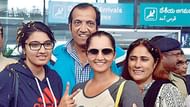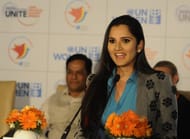Back in the 1990s, a 10-year-old with dreams in her eyes used to watch awe-struck as a teenage Martina Hingis ruled the tennis world. The young girl wanted to follow in the footsteps of the Swiss Miss, only to be mocked and laughed at by cynics who questioned her very ambition – “How can she even dream of becoming the next Martina Hingis?”
That young girl has now taken her second hat-trick of titles after winning the China Open, partnering with the same Swiss Miss she idolised.
Nearly two decades later, it is the same girl – Sania Mirza – who is now on top of the world in women’s doubles. Ironically, Hingis is her current partner and they are the world’s most dominant duo this season.
For Mirza, the journey from wide-eyed fledgling talent to sportswoman at the pinnacle of the game has not been the smoothest. Instead of her game alone being in the spotlight, her life choices, dressing style, opinions and even her marriage have been scanned and scrutinized in the Indian public eye. But Mirza was too stubborn and believed too much in herself to let any external force be an impediment to her success.
“You’ve got to be stubborn and not be easily distracted to be able to achieve something. Especially as a girl in our country, you must believe you belong,” points out the World No. 1.
That firm and unshakeable self-belief is what fuelled her ambitions right from a young age and filled her with a confidence and fearlessness that could never be dented easily. She was obdurate and relentless in her pursuit of glory; there was a persistence in her that was hitherto not seen among girls playing tennis in India.
The headlines that India had made before Mirza in tennis were all through its male champions. The only girl to impress before Sania was Nirupama Vaidyanathan, who made it to the second round of the 1998 Australian Open.
But Mirza was all about breaking the stereotype. Being the trailblazer was a quality ingrained in her, and she would not back off.
Fed Cup captain Enrico Piperno, who was once the coach of doubles legend Mahesh Bhupathi, recalled meeting the young Hyderabadi girl at the junior French Open in the latter half of the 1990s. Piperno was blown away by her guts when she came up and expressed a desire to hit with Bhupathi. “Even at that age, Sania Mirza was unlike other Indian girls who would typically prefer to hide in one corner,” he said.
A bright singles career
Piperno was right. A few years later in 2003, it was the same girl who found fame on the hallowed lawns of Wimbledon when she won the junior doubles title with Alisa Kleybanova and in the process, became India’s first female junior Grand Slam champion. Turning professional the same year, it was a matter of time before she won the ‘WTA Newcomer of the Year’ award for her excellent 2005 season.
That year, she sizzled at the Grand Slams on her debut, making it to the fourth round of the US Open, and she also broke into the top 50, peaking at 31. The season also saw her capturing her first singles title at home, which was followed by her first top 10 scalp as she stunned the reigning US Open champion Svetlana Kuznetsova in Dubai.
That fluid forehand, endowed with pace and power, was the talk of the town that wreaked havoc on names such as Marion Bartoli, Vera Zvonareva and Nadia Petrova. Her vivacious personality and the slogans on her tees grabbed attention everywhere – Sania was every bit the new star from a non-cricket sport that India needed.
Refusing to cower
The length of her skirts and her dressing sense invited the ire of fundamentalist religious clerics, who issued fatwas and threatened to prevent her from playing if she did not wear clothes they deemed ‘decent’.
This did not deter the 18-year-old; instead, it steeled her for the bigger battles ahead. Mirza would not cower under pressure and that, in retrospect, helped to embed the seeds of her now phenomenal success.
“I believe in myself and in the things I do a lot, and that’s my biggest strength as a person."
That would be her biggest weapon throughout her career. Her marriage to Pakistani cricketer Shoaib Malik in 2010 created a furore and she was disowned by many Indians who began calling her a Pakistani.
It was around that same time that a bright singles career that saw her climb to 27 in the rankings and notch wins over Hingis, Victoria Azarenka and Dinara Safina started to get cut short.
Her body, weakened by three joint-related surgeries, could not take the grind of singles tennis anymore, and she gave it up altogether after 2012. It was a huge setback but she was far too passionate about the sport to stay away from it.
Embracing doubles and creating history
Mirza took to doubles as her only way of remaining a part of professional tennis. After devoting three full seasons solely to doubles, today she is the World No. 1 – once again something unprecedented for an Indian woman.
One of Mirza’s greatest characteristics is the fact that she never stops learning. The doubles game requires perfect coordination, chemistry and trust with the partner to make split-second decisions on the court. The last three years, Mirza has been improving by leaps and bounds. From choosing the right partner to identifying the right shot to showing variation on the court – she is now doing it all much better.
Her doubles career has been on an upward trajectory since 2012, and it all culminated in selecting Hingis as her partner right before Indian Wells this year. Their games perfectly complement each other. Eight titles in nine finals have followed so far, including triumphs at Wimbledon and the US Open – the pair is the most feared on the circuit currently and they do not intend to stop anytime soon.
Support system
Every success story needs an unflinching support system. And Sania's case is no exception. One of her biggest assets is her family’s unconditional love and backing that have seen her tide over testing times.
From charting her career, to travelling constantly with a young Sania and keeping her grounded – her parents, Imran and Naseema, have played a role that was essential for building the Sania Mirza that we know today.
Speaker on social issues
Through the years, Mirza's popularity has exploded, as have her exploits on the tennis court. She now has the power to speak out on a variety of social issues, no matter even if they happen to stoke controversy. Being thoroughly opinionated and strong-willed, Mirza has to face a barrage of attack nearly every time she makes any statement that goes against convention.
But she has learnt to hit back at her critics, who have never dissuaded her from becoming a strong voice. Fittingly, last year that voice was given an even bigger responsibility when she was made the UN Women Goodwill Ambassador for South Asia. She became a role model and an advocate for gender equality across the region, encouraging women to not let go of their dreams.
And she is doing it in her own backyard too. Mirza has opened her academy in Hyderabad in 2013 which is her way of giving back to the sport that has given her her identity. Today, little girls want to be like this 28-year-old who, quite deservedly, was bestowed the Rajiv Gandhi Khel Ratna award recently.
Sania has helped in liberating the middle-class Indian mindset when it comes to choosing a career for their daughters, and that is probably her biggest achievement.
“You have to believe that as a woman and as a girl that you are not a weakness, you’re a strength. And it’s possible. If you put your mind to it, you put sacrifices to it, you put hard work to it, anything is possible, no matter where you’re from.”
Can there ever be words more inspiring than this?


